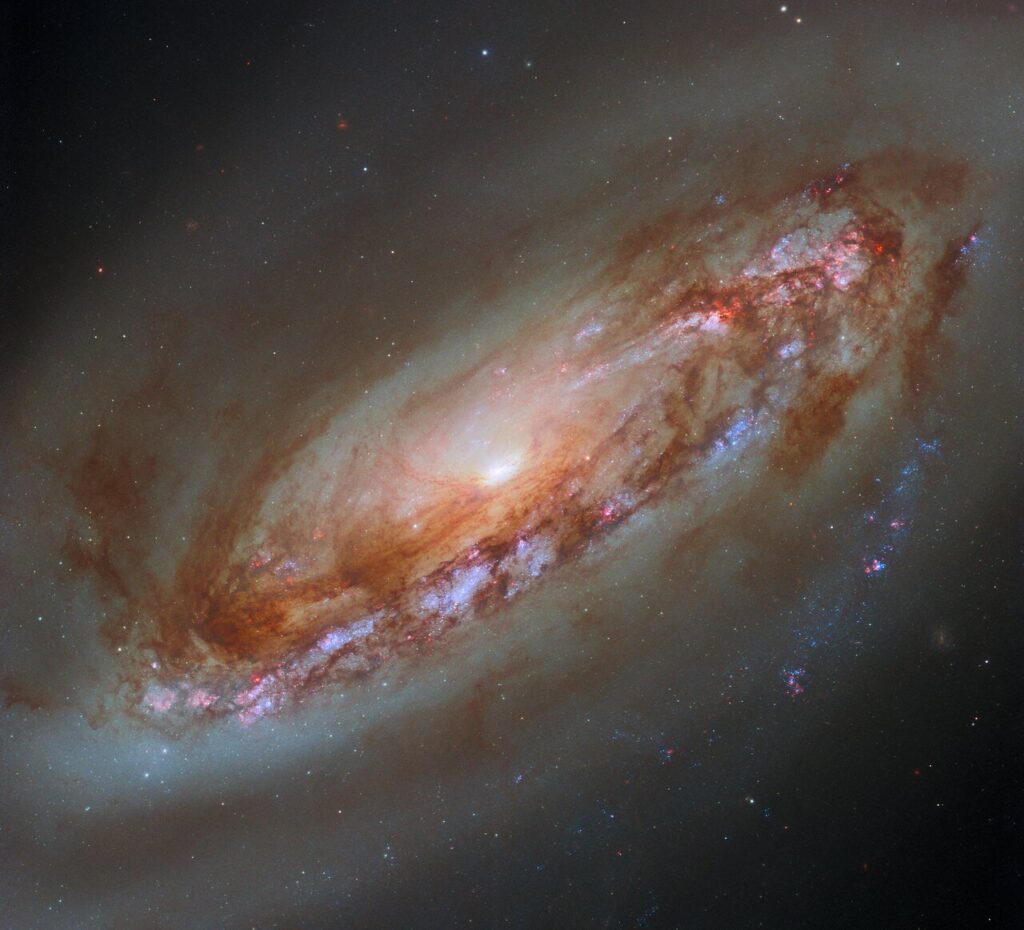Hubble has just captured a mesmerizing new image of Messier 90, a galaxy that’s not only unique for moving toward Earth but also for undergoing major changes as it loses gas in its journey through the Virgo Cluster.
A Stunning New Image of Messier 90
Hubble’s new image of Messier 90 is more than just a beautiful visual. It is a window into the changing life of a galaxy in transition. While galaxies generally move away from us due to the expansion of the universe, M90 is an exception. It’s coming closer. This latest image, captured with the Wide Field Camera 3 (WFC3), installed on Hubble in 2010, reveals stunning details of M90’s structure, including a bright core, a dusty disc, and a gaseous halo. This new image offers a more detailed view than ever before, surpassing earlier photographs taken by Hubble in 1994.

The image also raises significant scientific questions: What does M90’s movement tell us about galaxy evolution? How is the dense gas within the Virgo Cluster impacting M90’s ability to form new stars? And, what can astronomers learn from observing a galaxy that is losing its gas and transforming before our eyes?
What is Messier 90 and Why Is It Unique?
Messier 90, also known as NGC 4569, is a spiral galaxy situated in the Virgo Cluster, a collection of around 1,300 to 2,000 galaxies. M90 is located approximately 55 million light-years from Earth and, unlike most galaxies, it is on a path that brings it closer to us. Most galaxies are moving away from Earth due to the universe’s expansion, but M90’s orbit through the Virgo Cluster has accelerated it toward our planet. It is one of the few galaxies exhibiting blueshift, meaning its light waves are compressed as it moves toward us.
Astronomers have measured M90’s velocity as being so high that it’s in the process of escaping the gravitational pull of the Virgo Cluster entirely. As it travels through this cluster, M90 is being impacted by the cluster’s dense intergalactic medium. The result is that the galaxy is losing gas at a rapid rate, stripping away the fuel it needs to form new stars. This loss of gas is a phenomenon known as ram-pressure stripping, which occurs when a galaxy moves through a dense environment, much like how wind would strip the leaves from a tree.
Hubble’s Technological Leap: Revealing the Details of M90
The new image of Messier 90 captured by Hubble’s WFC3 reveals significant details about the galaxy’s structure and ongoing changes. The core of M90 is extremely bright, and the dust disc surrounding it is clearly visible. The image also shows a gaseous halo surrounding the galaxy, indicating the loss of gas as M90 travels through the Virgo Cluster.
The Wide Field Camera 3 is a major technological upgrade over its predecessor, the Wide Field and Planetary Camera 2 (WFPC2), which captured an earlier image of M90 in 1994. That earlier image, while impressive for its time, had a distinctive stair-step pattern due to the layout of the older camera’s sensors. With WFC3, astronomers can now observe M90 with much greater clarity, enabling them to see the intricate details of the galaxy’s dusty disc, gaseous halo, and star-forming regions.
This technological leap allows scientists to better understand how galaxies evolve. The level of detail in the new image shows the regions where star formation is actively occurring, highlighted by red H-alpha light from nebulae. However, this light is only present in the inner regions of the galaxy, further illustrating how M90 is losing its ability to form new stars.
M90’s Motion Through the Virgo Cluster: A Galaxy in Transition
M90’s journey through the Virgo Cluster is a fascinating example of how galaxies evolve over time. As M90 travels through the dense gas at the center of the Virgo Cluster, it experiences significant pressure that strips away its gas, preventing it from forming new stars. This process, known as ram-pressure stripping, is visible in the diffuse halo of gas surrounding the galaxy in Hubble’s image.
The loss of gas is a key factor in determining the future of M90. Without the gas needed for star formation, M90 will eventually transition from an active spiral galaxy into a more passive lenticular galaxy, which is characterized by little or no star formation. Lenticular galaxies are often found in dense clusters, where the environment has stripped them of the material they need to form new stars. M90’s transformation is a glimpse into the future of many galaxies in similar environments.
This process of galaxy transformation provides astronomers with valuable insights into how galaxies evolve over time. By studying M90, scientists can better understand the factors that cause galaxies to lose gas and transition from one type to another. The fact that M90 is moving closer to Earth also makes it an ideal target for future observations, as astronomers will be able to track its evolution over time.
The Science Behind Galaxy Evolution
One of the most important questions in astronomy is how galaxies evolve over time. By observing galaxies like M90, astronomers can gain insights into the different stages of galaxy evolution. Spiral galaxies like M90 are typically rich in gas, which allows them to form new stars. However, as galaxies move through dense environments like the Virgo Cluster, they can lose their gas and transition into more passive types, such as lenticular or elliptical galaxies.
M90’s motion through the Virgo Cluster is a prime example of this process. As the galaxy moves through the cluster, it encounters dense clouds of gas that strip away its own gas. This process will eventually prevent M90 from forming new stars, causing it to fade and transition into a lenticular galaxy.
By studying galaxies in different environments, astronomers can piece together the life cycles of galaxies and understand the factors that drive their evolution. Observing galaxies like M90 is particularly important because it provides a real-time example of a galaxy in transition.
Why M90’s Journey Matters for Astronomy
M90’s journey through the Virgo Cluster is not just a fascinating case study in galaxy evolution—it also has broader implications for our understanding of the universe. By observing M90, astronomers can better understand how galaxies interact with their environments and how these interactions shape their evolution. The fact that M90 is moving closer to Earth also makes it an exciting target for future observations, as astronomers will be able to study its changes in even greater detail over the coming decades.
Moreover, M90’s transition from a star-forming spiral galaxy to a more passive lenticular galaxy is a process that many galaxies in the universe will undergo. Understanding this process is key to understanding the life cycles of galaxies and the role that dense environments like galaxy clusters play in shaping the universe.
Conclusion: A Galaxy in Motion, A Universe in Change
The new image of Messier 90 captured by the Hubble Space Telescope provides more than just a stunning visual of a distant galaxy. It offers a unique glimpse into the process of galaxy evolution, showing how galaxies like M90 lose their ability to form new stars as they move through dense environments. M90’s journey through the Virgo Cluster and its movement toward Earth make it an ideal target for future observations, as astronomers continue to study its transformation from an active spiral galaxy to a passive lenticular galaxy.



















